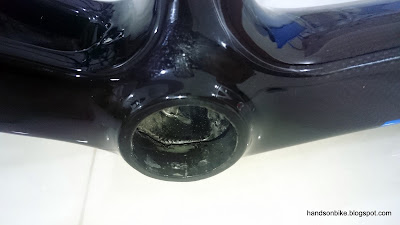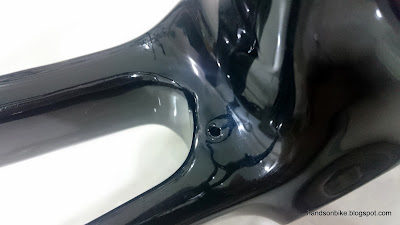Java Freccia carbon mini velo frameset
Overlaying the new Java frame onto the Wheelsport mini velo for comparison
I tried to line up both the front and rear axles, but the bottom bracket does not line up. The geometry seems to be quite different...
Different top tube design, although the horizontal top tube length seems to be similar
Bottom bracket for the Java frame seems to be higher up
Front axle lined up nicely, acting as a datum for comparison
Rear axle of Java frame does not match up nicely, suggesting a shorter chain stay length
Seat tube angle and location seems to be similar
Head tube of the Java frame is much higher, which should translate into more stiffness at the front end since the exposed length of the steerer tube is shorter.
Steerer tube of the Java fork ends about 40mm below that of the Wheelsport fork, which means a more aggressive riding geometry.
That concludes the frame comparison with the Wheelsport mini velo. With a shorter steerer tube, it will mean a lower handlebar height for the Java Freccia mini velo and thus a more aggressive riding posture.
Next, I also compared the frame with the Merida Scultura 5000 road bike.
Just to double check: The Wheelsport handlebar is quite a bit higher than the Merida handlebar. The Java handlebar height should thus end up pretty close to that of the Merida road bike.
Overlaying the Java Freccia frame onto the Merida Scultura 5000 road bike, using the bottom bracket area as the datum.
Top tube height is obviously lower on the mini velo frame
Steerer tube height is about the same as that of the Merida road bike. This means that the handlebar height of the Java should be close to that of the Merida.
After doing more research, I finally found some details of the Java Freccia frame dimensions. What stood out for me was the chain stay length, which is short at only 380mm! This is quite a bit shorter than the 405mm on the Merida and the 420mm on the Wheelsport.
Frame dimensions of the Java Freccia frame
The major findings from this frame comparison is the difference in head tube length with the Wheelsport frame, and also the short chain stay length. A short chain stay length usually means a more agile but also less stable ride. Nevertheless, all these numbers should only be used as a reference, as the ride quality and characteristics ultimately depends on riding the actual bike. It may or may not have a big effect on the ride at all.






















































